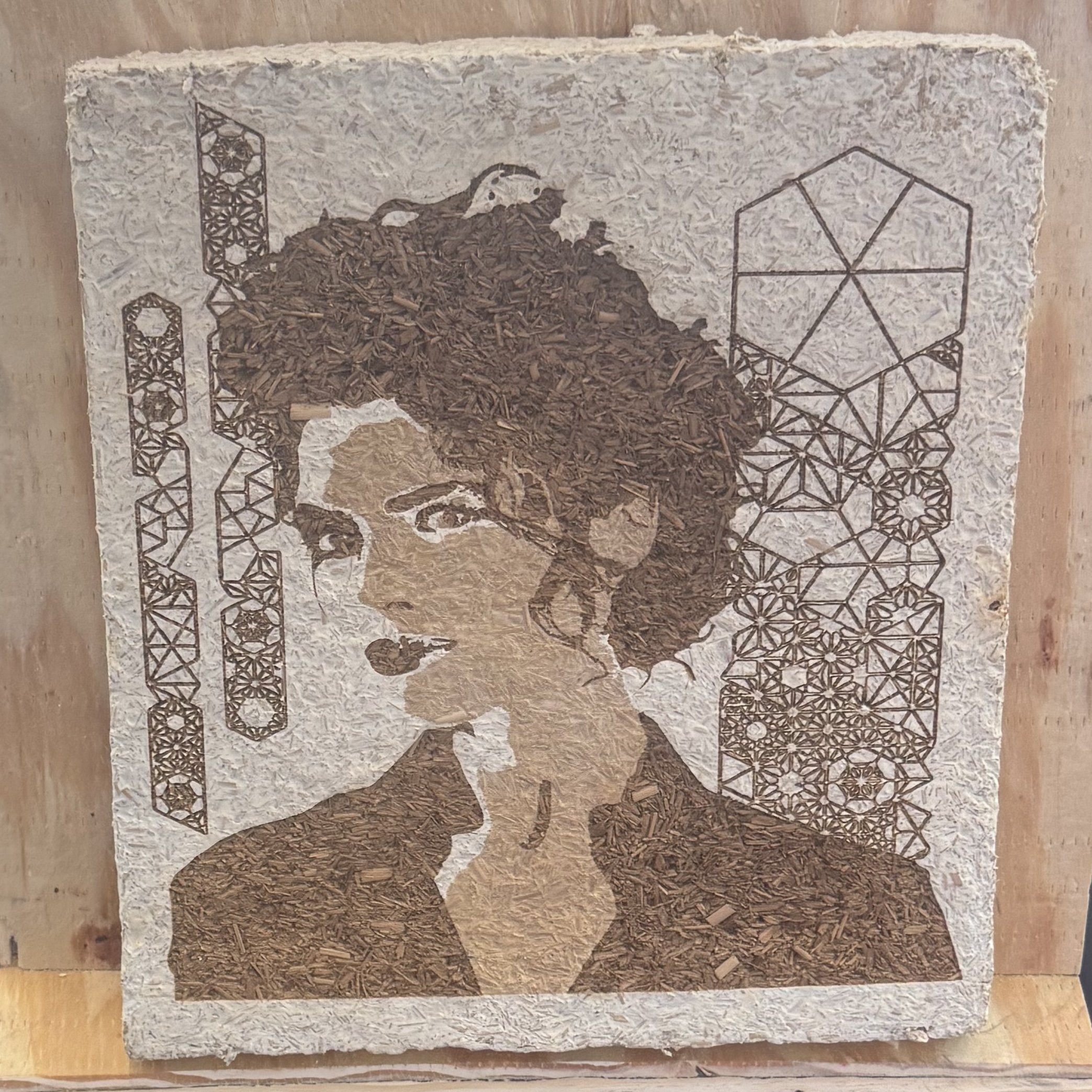Mycelium Art
Mycelium Art
This piece honors Dr. Neri Oxman, a visionary designer and founder of the Mediated Matter Group at MIT, whose work explores the profound intersections between biology, computation, and design. Laser-etched into a living medium of mycelium, the portrait is more than an image—it is a metaphor for regeneration, decay, and renewal. Like Oxman’s philosophy of Material Ecology, this artwork is grown, not manufactured.
The mycelium panel was cultivated using a Grow-It-Yourself biofabrication kit, integrating agricultural waste and fungal mycelium into a biodegradable canvas. Over the course of several days, the piece was shaped by living systems—then sealed, dried, and precision-etched with a laser to reveal Oxman’s likeness layered within a geometric web of biomorphic architecture.
The intricate patterns surrounding her reflect her design language—nods to natural structures like exoskeletons, coral reefs, and silk threads—each geometry acting as a bridge between the organic and the engineered. The use of laser technology and fungal biology mirrors her ethos: that the future of design is neither synthetic nor natural—but symbiotic.
InfluenTial Actors
Neri Oxman
A trailblazer at the intersection of architecture, biology, and computation, Neri Oxman is the founder of the Mediated Matter Group at the MIT Media Lab. Her groundbreaking research in Material Ecology explores how digital fabrication and living systems can merge to produce biodegradable structures and biomimetic forms. Oxman’s work has redefined what it means to “grow” buildings and design with life itself—shaping everything from wearables to pavilions that adapt, decompose, and regenerate. Her projects provoke fundamental questions about sustainability, identity, and our relationship to the natural world.
“Nature doesn’t design in parts but in systems.” – Neri Oxman
suzana Lee
As the founder and CEO of Biofabricate, Suzanne Lee is pioneering a materials revolution. A leading figure in biofabrication, she advocates for a future where materials like leather, silk, and foam are grown—not manufactured—using microbial processes and cellular agriculture. Lee’s work brings together designers, scientists, and startups to build an ecosystem around materials that are regenerative by design. Her legacy includes founding Biocouture, the first fashion label to explore microbial materials, and continuing to shape global discourse on how biology will power the next industrial era.
“If we can grow it, why should we extract it?” – Suzanne Lee
Daniel Schmachtenberger
Sarah Hogan-Cone
Daniel Schmachtenberger is a systems thinker, philosopher, and social architect whose work spans complex systems science, global health, meta-crisis analysis, and civilization design. He is a founding member of The Consilience Project, an initiative focused on elevating public sensemaking and fostering collective intelligence to address the root causes of systemic risk. Schmachtenberger is known for articulating the interconnected crises—ecological, economic, social, and technological—that challenge our current models of progress, and for offering frameworks that invite regenerative, anti-fragile alternatives rooted in complexity and stewardship.
With a deep commitment to planetary health and long-term thinking, his work encourages audiences to confront existential risks not just through innovation, but through the evolution of our sensemaking, culture, and shared purpose.
“Regeneration is not just healing ecosystems—it’s rethinking civilization from first principles.” – Daniel Schmachtenberger
Sarah Hogan-Cone is a systems leader and regenerative design advocate with a background in landscape architecture, education, and social impact. Her work spans academia, consulting, and nonprofit ecosystems—focusing on how systems thinking, ecological literacy, and leadership development can drive regenerative transformation across sectors. Sarah integrates frameworks like Doughnut Economics and Living Systems Theory into practical implementation, helping communities and institutions move from sustainability to regeneration. She’s also active in collaborative learning initiatives that bridge ecological science, storytelling, and community design.
“Regeneration starts with remembering that we are nature.” – Sarah Hogan-Cone





